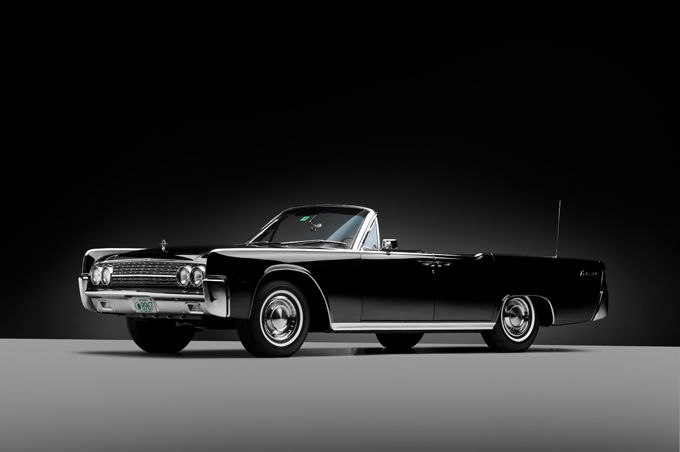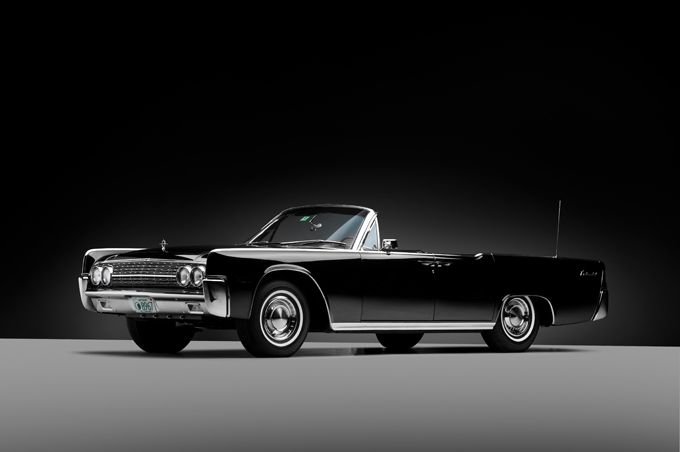
This 1962 Lincoln Continental convertible was acquired by William Rodina of Bridgewater, CT, after a full restoration was done on the car. Contours and paint are all excellent, and the exterior brightwork is of very good quality. The odometer indicates slightly fewer than 75,000 miles, which is believed to be correct.
The car has power steering and brakes, air conditioning and power seats, as well as an AM radio. This example, in triple black, is particularly desirable — the automotive embodiment of a black-tie dinner.
(Introductory description courtesy of RM Auctions.)
SCM Analysis
Detailing
| Vehicle: | 1962 Lincoln Continental convertible |
| Years Produced: | 1961-69 |
| Number Produced: | 3,212 (1962 convertibles) |
| Original List Price: | $6,721 |
| SCM Valuation: | $40k-$60k |
| Tune Up Cost: | $200 |
| Distributor Caps: | $25 |
| Chassis Number Location: | Front body pillar between the left front door hinges |
| Engine Number Location: | Stamped on pad on driver's side of engine block, forward of cylinder head |
| Club Info: | www.lcoc.org |
| Website: | www.lincoln-club.org |
| Alternatives: | 1962 Cadillac Eldorado convertible, 1962 Chrysler 300H convertible, 1962 Crown Imperial convertible |
| Investment Grade: | C |
This Lincoln Continental, Lot 835, sold for $88,000, including buyer’s premium, at RM’s sale of the Dingman Collection in Kensington, NH, on June 9–11, 2012.
Special collections, especially those that are purposely focused on a specific marque, style, or era, have a tendency to produce remarkable results for both the auction house and the seller.
This was the case with the Michael Dingman Collection. Dingman, who served as a Ford Motor Co. director for 21 years, was also an experienced race driver who personally competed in Fords, driving Roush-prepared Mustangs in the SCCA’s Trans-Am Series in the early 1990s. His collection focused on rare and desirable Fords and Lincolns, including this Continental convertible.
It’s all about style
Beginning in 1961, the newly designed Lincoln Continental hit the showroom floors to rave reviews. The body was smaller than the outgoing model, vastly more modern, sleek and set a new styling tone for American luxury sedans and convertibles.
The new design used suicide doors, which even today are quickly noted by even casual automotive newbies.
The convertible was also the first four-door open car offered in the marketplace by a major U.S. manufacturer since the end of World War II. More than 25,000 freshly minted Lincolns were sold during the 1961 model year — a smashing success for the car’s designer, Elwood Engel, who was solely responsible for the entire design, from the sophisticated folding power top to the stylish body lines.
Easy power, big comfort
When I was in high school, my mother’s employer let me drive around his 1961 convertible for a few weeks with the promise that I’d fix it up for him and try and massage the paint back to life. The job took longer than I thought — not because it was a difficult and time-consuming project, but because my high school buddies and I discovered that at least six of us could pile in the car and cruise around town in it with the top down.
I’ve always loved fourth-generation Lincolns. The slab styling looks great, and the smooth power of that massive 300-hp 430-ci fuel-guzzling V8 pulls you down the road effortlessly, nearly like floating on a cloud. Steering and suspension feedback is nearly nil, and that’s just how most luxury buyers of the era wanted it — this car was just the thing for cruising down the road to the local supper club, without spilling your martini on the way.
Keep in mind this was the 1960s — cocktail parties were the norm, with 10-foot-long walnut stereophonic consoles spinning out tunes from the Rat Pack while the sound of stainless steel cocktail shakers blended into the background music. It was a cool time, and cool cars fit right in — thus the success of the new Lincoln Continental.
Can’t go wrong with black
When done right (which is exceedingly difficult to do), black cars will generally ring the auction bell with a distinctive tone. It’s the sound of wallets cracking open and auction paddles wafting through the air.
Our subject car was finished in arguably the best color for an open Lincoln luxury car (or any luxury car, for that matter). Mate that to a “triple black” combination, meaning a black interior and top, and this was one of the most striking presentations that money can buy. The restoration looked to be fading in spots, with some evidence of the onset of a proper patina gently aging certain components and materials. And the engine bay appeared to be in rather good shape, with the proper stickers, hoses and clamps.
The Kennedy legacy
Editor Pickering asked if I felt that the car was somehow stigmatized by the assassination of John F. Kennedy, who was killed in a 1961 model. Did that tragic event affect the value of the convertibles, especially given one finished in black? I simply don’t believe so.
Production figures, even for the convertibles, did not drop after the assassination, and the cars’ values have fluctuated over time. I believe that the car stands on its own merits and epitomizes the essence of the luxury segment during the early 1960s. While some collectors might suggest that values have increased based on the presumed connection to the assassination of a beloved president, it really doesn’t connect for me other than “this was the same model car he was riding in on that fateful day in 1963.”
The top-down analysis
Traversing the ACC database, I found a well-rounded selection of good comparables — so many that I was actually able to select black examples only. Based on the photos, we can assume that our subject car was, or was very close to, a solid #2 example.
Recent values seem to range from about $25,000 for a fairly rough-around-the-edges #4 example to about $65,000 for a more refined offering. The highest selling recent sale in our database belongs to Lot 202, which sold at RM’s Phoenix, AZ, auction on January 19, 2012, for $66,000. This car was reported to be in #2+ condition — a very fine example that supported the price paid. There are numerous examples that found a number squarely in the middle $40ks, which certainly suggests that range as the middle of the market for #3 drivers, which remain in very good condition.
Our subject car’s $88,000 price trumps our previous high sale, Lot 202 from RM Phoenix, by a crisp $22,000.
The market has been fast moving as of late. Values have been apparently spiking, then settling down to a more normalized level. Our subject car may have been the result of two well-heeled investors simply proving to each other who has the larger checkbook — or, the value could be chalked up to the magic of a private collection sale.
RM’s pre-sale estimate was squarely in the proper range of $50,000–$60,000. Given that, and the market research, I think this car was very well sold. Or perhaps it’s a harbinger of things to come. 
